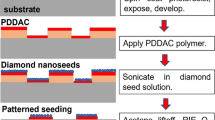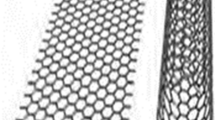Abstract
The field emission characteristics of patterned carbon nanotubes (CNTs) the average diameter of which is 16 nm cathodes on substrates with different surface treatments were investigated. The surface treatments of the substrate were performed by nickel electroless plating and palladium coating, which is an activation procedure of electroless plating. CNTs were patterned on the surface-treated substrate with radius of 200 μm through conventional photolithography process. Two deposition methods, electrophoresis deposition and spray deposition, were used to investigate the effects of deposition methods on field emission characteristics of the cathodes. It was revealed that the two deposition methods showed similar turn-on field trends, which means that the different surface morphologies of the substrates have more influence on the field emission characteristics than the different deposition methods performed in this study. Through the surface treatments, the roughness of the surface increased and cathodes with a high roughness factor showed better field emission characteristics compared to non-treated ones.





Similar content being viewed by others
References
Bonard JM, Croci M, Arfaoui I, Noury O, Sarangi D, Châtelain A (2002) Can we reliably estimate the emission field and field enhancement factor of carbon nanotube film field emitters? Diam Relat Mater 11:763–768
Charbonnier M, Alami M, Romand M (1998) Electroless plating of polymers: XPS study of the initiation mechanisms. J Appl Electrochem 28:449–453
Chen Z, Zhu F, Wei Y, Jiang K, Liu L, Fan S (2008) Scanning focused laser activation of carbon nanotube cathodes for field emission flat panel displays. Nanotechnology 19:135703
Chen PY, Cheng TC, Tsai JH, Shao YL (2009) Space charge effects in field emission nanodevices. Nanotechnology 20:405202
Choi WB, Chung DS, Kang JH, Kim HY, Jin YW, Han IT, Lee YH, Jung JE, Lee NS, Park GS, Kim JM (1999) Fully sealed, high-brightness carbon-nanotube field-emission display. Appl Phys Lett 75:3129–3131
Collins PG, Zettl A (1997) Unique characteristics of cold cathode carbon nanotube-matrix field emitters. Phys Rev B 55:9391–9399
De Heer WA, Chatelain A, Ugarte DA (1995) Carbon nanotube field-emission electron source. Science 270:1179–1180
Gao B, Yue GZ, Qiu Q, Cheng Y, Shimoda H, Fleming L, Zhou O (2001) Fabrication and electron field emission properties of carbon nanotube films by electrophoretic deposition. Adv Mater 13:1770–1773
Jeong HJ, Choi HK, Kim GY, Il SY, Tong Y, Lim SC, Lee YH (2006) Fabrication of efficient field emitters with thin multiwalled carbon nanotubes using spray method. Carbon 44:2689–2693
Kim KS, Winograd N (1974) X-ray photoelectron spectroscopic studies of nickel-oxygen surfaces using oxygen and argon ion-bombardment. Surf Sci 43:625–643
Kim YC, Yoo EH (2005) Printed carbon nanotube field emitters for backlight applications. Jpn J Appl Phys 44:L454–L456
Kim WJ, Lee JS, Lee SM, Song KY, Chu CN, Kim YH (2010) Better than 10 mA field emission from an isolated structure emitter of a metal oxide/CNT composite. ACS Nano 5:429–435
Kong J, Franklin NR, Zhou C, Chapline MG, Peng S, Cho K, Dai H (2000) Nanotube molecular wires as chemical sensors. Science 287:622–625
Li J, Lu YJ, Ye Q, Cinke M, Han J, Meyyappan M (2003) Carbon nanotube sensors for gas and organic vapor detection. Nano Lett 3:929–933
Lim SC, Jang JH, Bae DJ, Han GH, Lee SW, Yeo IS, Lee YH (2009) Contact resistance between metal and carbon nanotube interconnects: effect of work function and wettability. Appl Phys Lett 95:264103
Mallory GO, Hajdu J (1990) Electroless plating: fundamental and applications. AESF, Orlando
Marcell P (1985) XPS study on surface and bulk palladium oxide, its thermal stability, and a comparison with other noble metal oxides. J Phys Chem 89:2481–2486
Ngo Q, Petranovic D, Krishnan S, Cassell AM, Ye Q, Li J, Meyyappan M, Yang CY (2004) Electron transport through metal-multiwall carbon nanotube interfaces. IEEE Trans Nanotechnol 3:311–317
Sasi B, Gopchandran KG (2007) Nanostructured mesoporous nickel oxide thin films. Nanotechnology 18:115613
Sharma RB, Late DJ, Joag DS, Govindaraj A, Rao CNR (2006) Field emission properties of boron and nitrogen doped carbon nanotubes. Chem Phys Lett 428:102–108
Sugie H, Tanemura M, Filip V, Iwata K, Takahashi K, Okuyama F (2001) Carbon nanotubes as electron source in an X-ray tube. Appl Phys Lett 78:2578–2580
Thomas BJC, Boccacciniw AR (2005) Multi-walled carbon nanotube coatings using electrophoretic deposition (EPD). J Am Chem Soc 88:980–982
Wu Z, Chen Z, Du X, Rinzler GA (2004) Transparent conductive carbon nanotube films. Science 305:1273–1276
Zhang Y, Franklin NW, Chen RJ, Dai H (2000) Metal coating on suspended carbon nanotubes and its implication to metal-tube interaction. Chem Phys Lett 331:35–41
Zhang JH, Yang G, Cheng Y, Gao B, Qiu Q, Lee YZ, Lu JP, Zhou O (2005) Stationary scanning X-ray source based on carbon nanotube field emitters. Appl Phys Lett 86:184104
Zhang JH, Wang X, Yang WW, Yu WD, Feng T, Li Q, Liu XH, Yang CR (2006) Interaction between carbon nanotubes and substrate and its implication on field emission mechanism. Carbon 44:418–422
Zhi CY, Bai XD, Wang EG (2002) Enhanced field emission from carbon nanotubes by hydrogen plasma treatment. Appl Phys Lett 81:1690–1692
Acknowledgments
This work was supported by the Industrial Core Technology Development Program funded by the Ministry of Knowledge Economy (No. 10037394), Seoul Metropolitan Government through Seoul research and business development (No. CR070054), World Class University (WCU, R32-2008-000-10082-0) project of the Ministry of Education Science and Technology (Korea Science and Engineering Foundation).
Author information
Authors and Affiliations
Corresponding author
Rights and permissions
About this article
Cite this article
Lee, K., Lee, Y.D., Kang, B.H. et al. The effect of surface treatments on the field emission characteristics of patterned carbon nanotubes on KOVAR substrate. J Nanopart Res 14, 890 (2012). https://doi.org/10.1007/s11051-012-0890-9
Received:
Accepted:
Published:
DOI: https://doi.org/10.1007/s11051-012-0890-9




